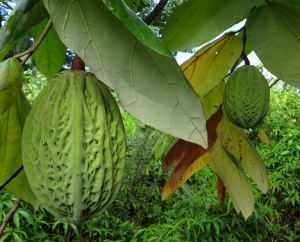
This is a picture of the Mayan Cacao which is called Balam in Toledo, Belize. The latin name is Theobroma bicolor; it is an unusual variety because the beans are actually white (as opposed to black/purple) and its pulp has a strong, pungent smell and taste. September to November is the usual harvest time and we are collecting them from our trees right now. They are usually ready when they fall off the tree and the fruit starts showing a yellow tinge. The fruit is esteemed by the Mayans here and they like to grind the fermented cacao beans to make a chocolate drink; in fact, they think the taste of this bean is better that the normal chocolate bean (theobroma cacao).
Toledo is hailed as a good cultivation area for cacao plantations; local farmers have been encouraged to plant normal cacao for international chocolate companies. The current feeling on this “White Cacao” amongst the chocolate-making community is that it is not a variety that imparts a taste familiar to high standard chocolate.
Well, I don’t really care about what top chocolatiers think because I like to eat and experiment with everything we have on the farm and I am not swayed by fads and fashion. Right now, we are drying and fermenting some beans out in the sun with a view to making our own home-made chocolate. I will keep you posted on what happens to our white chocolate. As an interesting aside, the pulp of the cacao has characteristic aromas similar to jack fruit (and durian) and because I like oriental smells, I think it is intensely fragrant and tasty.




